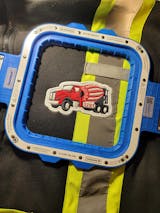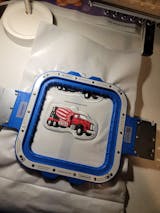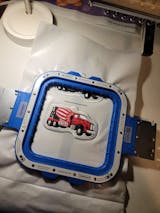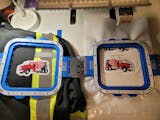1. Introduction to Sweatshirt Embroidery
Using best embroidery machines for sweatshirts is both an exciting opportunity and a technical challenge. Sweatshirt fabrics, with their cozy knits and stretch, offer a blank canvas for creative expression—think monograms, bold quotes, or intricate motifs. Yet, this same stretchiness can lead to puckering, distortion, or misaligned designs if you don’t use the right techniques. In this guide, you’ll discover the essential methods for flawless sweatshirt embroidery: from choosing stabilizers that prevent puckering, to mastering precise placement, to selecting the best tools and stitches for your fabric. Whether you’re a seasoned embroiderer or just starting out, you’ll find step-by-step strategies to overcome common frustrations and unlock new creative possibilities on every sweatshirt you stitch.
Table of Contents
- 1. Introduction to Sweatshirt Embroidery
- 2. Essential Techniques for Successful Sweatshirt Embroidery
- 3. Design Placement Strategies with Precision Measurements
- 4. Material and Tool Selection Guide
- 5. Creative Design Ideas and Personalization
- 6. Hand vs. Machine Embroidery: Choosing Your Method
- 7. Post-Embroidery Care and Longevity Tips
- 8. Conclusion: Mastering the Art of Sweatshirt Embroidery
- 9. FAQ: Solving Common Sweatshirt Embroidery Challenges
2. Essential Techniques for Successful Sweatshirt Embroidery
Sweatshirt embroidery isn’t just about threading a needle and hoping for the best. It’s a craft that rewards careful preparation, smart material choices, and a few pro tricks. Let’s break down the three pillars of flawless sweatshirt embroidery: stabilization, hooping, and stitch selection.
2.1 Stabilization Methods to Prevent Puckering
The secret to smooth, professional embroidery on sweatshirts lies in proper stabilization. Sweatshirt fabrics—often cotton or cotton-blend knits—are prone to stretching and shifting, which can cause designs to pucker or distort. Here’s how to keep your stitches crisp:
Cut-Away Stabilizer: The Go-To Choice Cut-away stabilizer is the gold standard for sweatshirt embroidery. It provides permanent support, staying attached to the garment even after washing, which is crucial for maintaining the integrity of your design on stretchy knits. Apply a medium-weight cut-away stabilizer to the back of your embroidery area, using a temporary spray adhesive for extra security. This method is especially effective for intricate or dense designs.
Tear-Away Stabilizer: For Less Stretchy Knits While tear-away stabilizer offers a clean finish, it’s generally less supportive for highly stretchy sweatshirt fabrics. If you do use it, double up with two layers for added stability—but keep in mind, cut-away is usually the safer bet.
Water-Soluble Toppings: Taming Texture For sweatshirts with a textured surface—think fleece or chunky knits—a water-soluble topping on top of the fabric keeps stitches from sinking in. This film dissolves after washing, leaving your embroidery crisp and elevated above the nap.
Fusible Stabilizers: Extra Security for Knits Some embroiderers use fusible stabilizers for additional support, especially on lightweight or particularly stretchy sweatshirts. Iron the fusible stabilizer onto the fabric’s wrong side before hooping to minimize shifting during stitching.
Pro Tip: Always pre-wash your sweatshirt before embroidering to prevent post-stitch shrinkage and distortion. Mark your design’s center and axis lines for precise placement, and trim excess stabilizer after stitching—leave about a half-inch margin for ongoing support.
2.2 Advanced Hooping Approaches
Hooping can make or break your embroidery project, especially with stretch fabrics like sweatshirts. Here’s how to get it right:
Inside-Out Hooping for Better Access Turn your sweatshirt inside out and apply the stabilizer to the back of the embroidery area. Then, turn it right side out, sliding the outer hoop inside the shirt and pressing the inner hoop in place. Align your marked reference points carefully for accurate design placement.
Tension Management: Taut, Not Stretched The fabric should be taut in the hoop—smooth and flat—but never stretched. Over-stretching can cause permanent distortion, while loose fabric can lead to puckering or misalignment. Think of it like tuning a drum: just enough tension for a clear, resonant “beat,” but not so tight that the fabric warps.
Effortless Fabric Security with Magnetic Hoops For those seeking both speed and precision, Sewtalent magnetic embroidery hoop offer a game-changing solution. These hoops use strong magnets to secure the fabric evenly, adapting to different thicknesses without manual screw adjustments. The result? Quick setup, reduced hoop burn, and consistent tension—especially handy when working with bulky sweatshirts or managing high-volume orders.
Managing Excess Fabric Roll up and clip any extra sweatshirt material to keep it away from the embroidery area. This prevents accidental stitching through unwanted layers and keeps your workspace tidy.
2.3 Stitch Selection and Needle Optimization
The right stitch and needle can mean the difference between a design that pops and one that puckers.
Needle Choice: Size 75/11 for the Win A size 75/11 embroidery needle is ideal for sweatshirt knits. It’s sharp enough to penetrate the fabric without leaving large holes, balancing strength and delicacy.
Stitch Selection: Backstitch for Stretch The backstitch is a favorite for stretch fabrics. It creates secure, even lines that resist gaping, perfect for lettering or outlines. Start one stitch ahead of your guideline, then stitch backward to reinforce each segment.
Thread Doubling Strategies For thinner sweatshirt fabrics, doubling your thread can add definition and durability. For thicker or denser threads, a single strand may suffice. Always test on a scrap first to see what looks and feels best.
Stitch Direction Flow Follow the natural flow of your design—whether it’s script lettering or a curved motif. Consistent stitch direction helps maintain fabric stability and gives your embroidery a polished, professional look.
Bonus Tip: Short stitches are less likely to pull away from the fabric, especially on stretchy knits. Keep your stitch lengths modest to maintain design integrity.
3. Design Placement Strategies with Precision Measurements
Embroidery is as much about where you place your design as how you stitch it. Strategic placement ensures your work looks intentional and fits the garment perfectly. Let’s explore the rules and creative tactics for chest, sleeve, and back embellishments.
3.1 Chest Placement Rules for All Sizes
Adult vs. Children’s Sweatshirts For adult sweatshirts and hoodies, the top of the design should sit about 3 inches down from the neckline when using an embroidery machine for hoodies—a sweet spot that balances visibility and comfort. For children’s sizes, move the design closer to the neck, typically 2.5 inches down, to suit smaller proportions.
Visual Alignment: Center-Fold and Ruler Techniques To find the true center, fold the sweatshirt in half along the center front, aligning the shoulder seams at the neckline. Mark the center point, then use a ruler to measure down from the neckline to your desired placement. Mark vertical and horizontal axis lines to guide your hooping and stitching.
Gender-Specific Variations Men’s and unisex sweatshirts often use slightly lower placements for a relaxed look, while women’s garments may benefit from positioning the design about an inch higher for better visual balance. For example, a men’s medium might be placed 7.75 inches down from the shoulder seam and 3.75 inches over from the center front, while a women’s medium could be 6.75 inches down and 3.5 inches over.
Template and Mockup Methods Print out your design at actual size and lay it on the sweatshirt to preview placement. Adjust as needed before marking your final position—this step is especially helpful for complex or multi-element designs.
3.2 Sleeve and Back Embellishment Tactics
Sleeve Embroidery: Seam-Ripping for Access For precise sleeve embroidery, use a seam ripper to open the sleeve seam up to the elbow. This allows you to hoop the sleeve flat, embroider as usual, and then sew the seam back up for a seamless finish. If you prefer not to open the seam, carefully float the sleeve over the hoop and secure it with pins or clips, ensuring the design is centered and the fabric is taut.
Back Placement: Full vs. Upper Back Full-back designs typically measure 8–12 inches wide and are positioned about 6 inches down from the neckline. For upper-back embellishments, use smaller designs (10–14 inches wide) and position them 1–6 inches below the neckline—ideal for logos or subtle branding.
Curved Neckline Embroidery For a trendy touch, use curved templates to align script or motifs along the neckline. Print your design, cut along the curve, and test placement before stitching. This approach works beautifully for personalized gifts or statement pieces.
Pro Tip: Always double-check your design orientation before stitching—especially when working on sleeves or the back. A quick preview can save you from upside-down surprises!
Ready to put these techniques into action? With the right stabilization, hooping, and placement strategies, you’ll transform any sweatshirt into a wearable work of art.
4. Material and Tool Selection Guide
Choosing the right materials and tools is the unsung hero of flawless sweatshirt embroidery. The wrong stabilizer or needle can turn your cozy canvas into a puckered mess, while the right combo makes every stitch sing. Let’s break down what works best for sweatshirts—whether you’re working with classic fleece, French terry, or a trendy cotton blend.
4.1 Stabilizer and Needle Combinations
Not all sweatshirts are created equal—nor should your stabilizer and needle choices be. The fabric’s weight, stretch, and texture all influence what you’ll need for crisp, durable embroidery.
Stabilizer Matchmaking:
- Fleece: This plush favorite is notorious for swallowing stitches. Your best bet? A medium-weight cut-away stabilizer. It provides permanent support, keeping designs sharp even after countless washes. For extra assurance, add a water-soluble topping on the fabric’s surface—this keeps stitches from sinking into the nap and ensures your design stands out.
- French Terry: Lighter and less fuzzy than fleece, French terry still benefits from a cut-away stabilizer, though you might opt for a lighter weight. If the fabric is extra stretchy, consider a fusible cut-away stabilizer, which irons onto the garment for added stability and minimizes shifting during hooping.
- Blends: For cotton-poly blends, stick with cut-away for stretch, but if the fabric feels more stable, a high-quality tear-away can work for simple, low-density designs.
Needle Know-How:
- Size 75/11 embroidery needles are the gold standard for sweatshirts. They’re sharp enough to pierce knits cleanly without leaving gaping holes, and their size balances thread flow with fabric protection.
- Always use needles designed specifically for embroidery, as they’re engineered for smooth thread delivery and minimal fabric damage.
- For particularly thick or dense sweatshirts, you may test a size 80/12, but always start with 75/11 and adjust only if needed.
Pro Tip:
Quality counts—professional-grade stabilizers and needles from reputable suppliers ensure consistent results and fewer headaches down the line.
Sewtalent Magnetic Hoop Compatibility:
If you’re looking to streamline your workflow, Sewtalent magnetic embroidery hoops are a game-changer for industrial embroidery machines. Their strong, even magnetic force secures thick sweatshirt fabrics without the struggle of manual tightening, making them especially useful for high-volume production or tricky materials like fleece. These hoops are compatible with a wide range of industrial embroidery machines, so you can count on effortless setup and reliable fabric tension every time.
4.2 Thread Choices for Knit Fabrics
Thread is more than just color—it’s the backbone of your embroidery’s look and longevity.
Polyester vs. Cotton:
- Polyester thread is the MVP for sweatshirt embroidery. It’s durable, resists fading, and stands up to repeated washing—perfect for garments that see a lot of wear. Its slight stretch also works harmoniously with knit fabrics, reducing the risk of breakage or puckering.
- Cotton thread offers a matte, classic look but is more prone to shrinking and fading over time. It can work for hand embroidery or vintage effects but isn’t as robust as polyester for machine work on sweatshirts.
Colorfastness and Weight:
- Always choose colorfast threads to keep designs vibrant through countless laundry cycles.
- For fleece and other thick sweatshirts, opt for a slightly heavier thread to ensure your design pops against the plush background. Lighter threads may get lost in the nap, especially on textured fabrics.
Fleece-Specific Recommendations:
- When embroidering on fleece, combine a polyester thread with a water-soluble topping. This duo keeps stitches sitting on top of the fabric, preventing them from disappearing into the pile and maintaining crisp, legible details.
Thread Management:
For multi-color designs, use thread stands to prevent tangling and ensure smooth feeding—especially important when working with multiple spools on industrial machines.
5. Creative Design Ideas and Personalization
Sweatshirt embroidery is your playground for creativity. Whether you’re personalizing a gift, launching a fashion line, or just adding flair to your own wardrobe, the possibilities are limitless. Let’s explore some of the most popular—and innovative—ways to make your sweatshirts truly one-of-a-kind.
5.1 Monograms and Quote Placement
Neckline Script Layouts: Curved neckline embroidery is having a major moment. To achieve that perfect arc, use a curved template—many embroidery software programs let you print your design in the exact shape you need. Cut it out and preview the placement on your sweatshirt before stitching. Script fonts work beautifully here, adding elegance and a custom touch.
Sleeve Lettering: Sleeve embroidery is all about precision. For names or quotes running down the arm, keep your lettering spaced evenly—about 1/2" to 3/4" apart for readability and visual appeal. Use a seam ripper to open the sleeve seam if you want a perfectly flat embroidery area, then stitch and resew for a seamless finish.
Seasonal Motifs: Don’t stop at names and quotes. Seasonal designs—like snowflakes for winter, florals for spring, or pumpkins for fall—add instant personality. You can find free machine embroidery designs for these seasonal motifs online. Place them on the chest, along the hem, or cascading down one side for a modern, asymmetrical look.
Pro Tip: Print your design at actual size and lay it on the sweatshirt to visualize placement. This step helps catch any alignment issues before you start stitching.
5.2 Innovative Techniques: Appliqué and 3D Effects
Side Bow Appliqué: Want to add dimension? Try a side bow appliqué. Stitch a decorative bow shape along the side seam, then carefully cut away the interior fabric to create a peek-through effect. Use a cut-away stabilizer for support—this technique combines embroidery with garment construction for a standout look.
Foam Padding for 3D Logos: For logos or motifs that leap off the fabric, foam padding is your friend—especially on fleece. Place the foam under your design area, stitch over it, and trim away the excess. This creates a raised, tactile effect that’s both eye-catching and on-trend.
Neon Color Trends: Bright, neon threads are everywhere right now, especially in gradient or fade patterns. Use them for bold, contemporary designs that pop against neutral sweatshirts. Neon hues are perfect for statement pieces or youth-oriented collections.
Quality Control: Always test your design on a scrap of similar fabric before committing to the final piece. This helps you fine-tune thread tension, stitch density, and color choices—ensuring your finished project looks as good as you imagined.
6. Hand vs. Machine Embroidery: Choosing Your Method
When it comes to sweatshirt embroidery, the choice between hand and machine methods isn’t just about tradition versus technology—it’s about matching your project’s needs, your timeline, and your creative goals.
6.1 Time and Complexity Comparison
Let’s break down the key differences between hand and machine embroidery for sweatshirts:
| Aspect | Hand Embroidery | Machine Embroidery |
|---|---|---|
| Equipment | Needle, embroidery floss, scissors, hoop, marking tools | Computerized embroidery machine, embroidery thread (usually polyester), 75/11 needles, stabilizer, hoop, software |
| Skill Level | Requires practice and patience; mastery of various stitches | Requires learning machine operation, digitizing software, and proper setup |
| Design Flexibility | Unlimited creative control; real-time adjustments possible | Dependent on digitized patterns; highly repeatable and consistent |
| Setup Time | Minimal—just transfer design and start stitching | More involved—requires design digitization, machine setup, and test stitching |
| Stitch Precision | Varies with skill; unique, organic look with slight variations | Highly precise and uniform; ideal for logos, monograms, and commercial work |
| Production Speed | Slow—simple designs may take hours; complex ones, days or weeks | Fast—complex designs can be completed in minutes; ideal for bulk orders |
| Scalability | Best for one-of-a-kind or small-batch projects | Excels at large-scale, repeatable production |
Hand Embroidery: Perfect for custom gifts, artistic pieces, or when you want each sweatshirt to have a unique, handmade feel. Techniques like the chain stitch and backstitch are popular for names, quotes, and motifs. The process is slow and meditative—each stitch is a tiny act of creativity.
Machine Embroidery: The go-to for commercial production, team apparel, or when consistency and speed are paramount. multi needle embroidery machine and digitized designs allow you to create intricate, repeatable patterns with minimal manual effort. Once you’ve set up your machine, you can produce dozens—or hundreds—of identical sweatshirts with professional polish.
Scalability: If you’re running a business or need to fulfill bulk orders, machine embroidery is the clear winner. For small batches or highly personalized projects, hand embroidery offers unmatched flexibility and charm.
In Summary: Choose hand embroidery when you want to pour your personality into every stitch. Opt for machine embroidery when efficiency, precision, and scalability are your top priorities.
Ready to take your sweatshirt embroidery to the next level? Whether you’re a hand-stitching artisan or a machine embroidery powerhouse, the right materials, creative ideas, and method will help you create wearable art that lasts.
7. Post-Embroidery Care and Longevity Tips
Caring for your embroidered sweatshirt doesn’t end when the final stitch is placed. The way you remove stabilizer, wash, and finish your garment can make all the difference in how your embroidery looks and lasts. Let’s break down the essential steps for post-embroidery care—so your designs stay crisp, vibrant, and wearable for years.
7.1 Stabilizer Removal and Washing Protocols
Cut-Away Stabilizer: Trim, Don’t Tear After finishing your embroidery, turn the sweatshirt inside out and carefully trim away the excess cut-away stabilizer. Leave about a half-inch margin around the design—this keeps the embroidery supported through wear and washing, while preventing scratchy edges against the skin. Unlike tear-away, you don’t want to remove all of the stabilizer; its ongoing support is crucial for stretchy knits.
Tear-Away and Water-Soluble Stabilizers If you’ve used tear-away stabilizer (best for less stretchy sweatshirts), gently tear it away after stitching. For water-soluble toppings—often used on textured fabrics like fleece—dissolve them with a targeted approach: use a watercolor water pen to apply water only where needed, minimizing fabric exposure and reducing the risk of color bleeding. This method is especially handy for intricate or colorful designs.
Washing Your Embroidered Sweatshirt Machine wash your embroidered sweatshirt in cold water on a delicate cycle. Cold water helps preserve thread color and prevents shrinkage or distortion of both fabric and embroidery. Use only mild detergents—never bleach or optical brighteners, as these can damage threads and fade colors. Fabric softeners are a no-go: they can affect thread texture and reduce the crispness of your stitches.
If you notice any color residue during washing, rinse the garment first in lukewarm water, then follow up with several cold water rinses until the water runs clear. This helps prevent color bleeding and keeps your design looking fresh.
Drying and Ironing Promptly remove your sweatshirt from the washer—don’t let it soak or sit in a wet pile, as this can cause thread loosening or color transfer. For drying, air-drying is safest, but if you use a dryer, stick to a low heat setting. Avoid wringing or aggressive spinning, which can distort both fabric and embroidery.
When ironing, always work from the reverse side of the garment. Place a cloth between the iron and the embroidery, and use medium heat without steam. Never iron directly on the design or while it’s damp; this protects the threads and maintains the integrity of your work.
Securing Stitches and Spot Cleaning Before washing, inspect your embroidery for any loose threads and secure them with a needle. For stains, gently dab around the embroidered area—never scrub directly on the stitches. If hand washing, soak the garment in mild detergent for 15–20 minutes, then rinse gently.
Long-Term Care For special pieces or dark colors, dry cleaning is possible—but avoid pre-spotting agents, which may react with embroidery threads. Always consult garment care labels and, when in doubt, test on a hidden area first.
By following these post-embroidery care tips, you’ll ensure your sweatshirt remains as stunning as the day you finished it—ready to be worn, gifted, or admired for seasons to come.
8. Conclusion: Mastering the Art of Sweatshirt Embroidery
Sweatshirt embroidery is both a science and an art—requiring the right stabilizers, precise placement, and a deep understanding of your materials. As you’ve seen, success comes from thoughtful preparation, careful stitching, and diligent aftercare. Don’t be afraid to experiment with new designs or techniques; every project is a chance to refine your craft and express your creativity.
And remember, efficient hooping tools like those from Sewtalent can make your embroidery journey smoother and more enjoyable, letting you focus on what matters most: bringing your unique vision to life, one stitch at a time.







